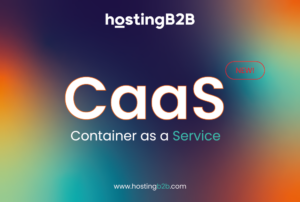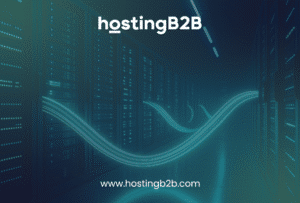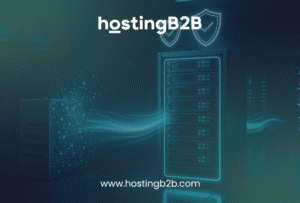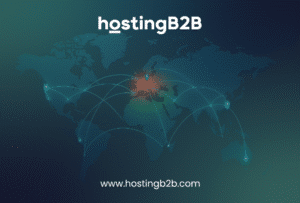
HostingB2B » Container as a Service
Containers as a Service CaaS Compliant Scalable Secure Platform
Easily run containerized applications without the hassle of server deployment and maintenance.

What is HostingB2B Container as a Service?
HostingB2B Container as a Service (CaaS) streamlines your container application deployment in the cloud. Benefit from intuitive container execution customized to your needs, while we expertly manage the underlying infrastructure.
A Simple, Scalable, and Secure Solution for Your Containers
Flexible
Manage containers via the HostingB2B Customer Portal or REST API.
Highly Available
Operate production-ready applications in containers with a 99.9% SLA.
Cost-Effective
Pay only for the duration your containers are active. No running containers? No charges.
Secure
Protect your containers from unauthorized access with API key authentication. Utilize private container registries with verified images.
Serverless
Eliminate the need to manage virtual machines, bare metal servers, or container orchestrators. Enjoy the easiest way to run containers in the cloud.
Autoscalable
Enable the scale-to-zero feature to run containers only when requests are received. Traditional autoscaling is available for handling traffic spikes.
SUPPORT & GUIDANCE
24/7/365 Free Premium Container as a Service Support
Most importantly, our round the clock Support is available for you via Live Chat, Ticket System (Email) and MS Teams.

Use Cases for Container as a Service
AI/ML Inference at the Edge
Running AI/ML models at the edge with CaaS provides scalability and portability, reduces latency, and enhances security.
• Low latency between IoT devices and ML models
• Containers execute on demand
• No need to manually provision servers
Streamlined Microservices
CaaS simplifies and optimizes the deployment of microservices and distributed systems, ensuring scalability, efficiency, and seamless management.
• Containers run on demand
• No need to manually provision servers
Integration with Third-Party Services
CaaS supports rapid deployment and scaling of containerized applications through API integration with third-party tools like GitHub Actions.
• Containers run on demand
• No need to manually provision serversservers
FAQ
Find answers to some frequently asked questions about Container as a service:
A platform for managing, deploying, and scaling containerized applications is offered by the cloud computing service model known as Container as a Service (CaaS). Much of the complexity of managing these components is abstracted away in a CaaS environment by the cloud provider, which provides the orchestration tools (like Kubernetes) and the underlying infrastructure (servers, operating systems, and container runtime).
Without having to worry about the underlying server provisioning, patching, or scaling, developers and IT operations teams can concentrate mainly on creating, packaging, and deploying their applications within containers. CaaS blends some of the simplicity of Platform as a Service (PaaS) with the flexibility of Infrastructure as a Service (IaaS).
Major cloud platforms’ Managed Kubernetes services are a well-known illustration of a CaaS (Container as a Service) offering. These services let users concentrate on deploying their containerized apps by abstracting away the hassles of maintaining the Kubernetes control plane.
These platforms offer a ready-to-use environment for deploying Docker or other container images by managing the underlying server infrastructure, Kubernetes master nodes, and related networking.
Developers and DevOps teams use CaaS mainly to make containerized application deployment, management, and scaling easier. Among its primary use cases are:
- Microservices Architectures: CaaS platforms are very good at coordinating and growing a lot of small, separate services that are part of a bigger application.
- Continuous Deployment/Continuous Integration (CI/CD) Pipelines: CaaS allows for quick deployment and testing of new code by integrating easily into automated development workflows.
- Hybrid and Multi-Cloud Deployments: CaaS assists in managing containers uniformly across various cloud environments or on-premises infrastructure, while containers provide portability.
- Rapid Application Development: Without having to worry about infrastructure provisioning, developers can quickly spin up environments for testing and implementing new features.
- Workloads with Varying Traffic: CaaS platforms are made to scale automatically, effectively managing demand variations.
Using a CaaS platform or an orchestration tool that supports this model is usually required to run a container as a service. Although a single Docker container can be operated on a server, “as a service” suggests extensive automation and management.
- Containerize Your Program: Create a Docker image with your application and all of its dependencies.
- Select a Platform for CaaS: Choose a managed solution from a leading cloud provider, such as Managed Kubernetes from HostingB2B.
- Describe deployment: Make a deployment configuration (such as a Kubernetes YAML file) that outlines the resource limits, scaling guidelines, and networking requirements for your containerized application.
- Deploy to the Cluster: To launch your application on the managed cluster, utilize the CaaS platform’s tools or API. After that, the platform takes care of scaling, scheduling, and container maintenance.
By automating the operational parts, this method enables you to effectively manage the lifecycle of your application.
By removing the complexity of the underlying infrastructure, CaaS gives users access to a managed environment designed especially for container deployment and orchestration. The operating system, a container orchestration engine (such as Kubernetes), and the server infrastructure are all hosted and maintained by the CaaS provider.
Users supply their container images and specify the deployment configuration they wish to use when deploying an application. Next, the CaaS platform manages automatically:
- Allocating CPU, RAM, and storage for containers is known as resource provisioning.
- Scheduling: Setting up containers on the cluster’s available nodes.
- Orchestration: Controlling the beginning, ending, scaling, and guaranteeing high availability of containers.
- Sending traffic to containers that are healthy is known as networking and load balancing.
- Providing instruments to track container performance is known as monitoring and logging.
This lowers the user’s operational overhead and optimizes the deployment pipeline.
For Container as a Service (CaaS), Kubernetes is the de facto standard orchestration engine. One of the best examples of CaaS is managed Kubernetes offerings. In essence, a cloud provider is offering Kubernetes as a Service when they offer a “Managed Kubernetes” service.
They oversee the uptime, upgrades, and scalability of the Kubernetes control plane. After that, users can deploy and manage their containerized apps (like Docker containers) by interacting with this managed Kubernetes environment. Therefore, even though Kubernetes is the underlying technology, a managed Kubernetes service makes it easier for end users to use by delivering it in the CaaS model.
With differing degrees of abstraction and user accountability, CaaS (Container as a Service) and SaaS (Software as a Service) are two distinct layers in the cloud computing stack.
- Container as a Service, or CaaS, offers a managed platform for setting up and managing your own containerized apps. The provider controls the container orchestration engine and underlying infrastructure while you bring your application code in containers. Both the container configuration and your application are under your control.
- Software as a Service, or SaaS, is a subscription-based online service that provides a fully functional software application. The application, its supporting infrastructure, and updates are all under the provider’s control. Users only need to use a web browser or client application (like Gmail or Salesforce) to access and utilize the software.
Essentially, SaaS allows you to use the completed application, while CaaS allows you to manage the application inside the container.
The main goal of CaaS (Container as a Service) is to help developers and IT operations teams deploy, scale, and manage containerized applications more quickly and easily. It serves as a link between fully managed applications (PaaS/SaaS) and raw infrastructure (IaaS).
With CaaS, businesses can take advantage of containerization’s advantages—like portability, efficiency, and consistent environments—without having to deal with the knowledge and operational strain of starting from scratch with a complicated container orchestration platform like Kubernetes. Faster development cycles, enhanced application agility, increased availability, and more effective use of resources are made possible by this.
The container orchestration engine itself, as well as different command-line interfaces (CLIs) and APIs for interaction, are usually the main tools utilized in a CaaS environment.
- The majority of CaaS platforms offer Kubernetes as their primary orchestration tool.
- Container Runtimes: These include CRI-O and containerd, which run the containers.
- Container Registries: Programs that store and retrieve container images, such as Docker Hub, Amazon ECR, or Google Container Registry.
- Tools for the Command Line: To communicate with the CaaS platform, you must use kubectl (for Kubernetes).
- APIs: For integration into CI/CD pipelines and programmatic control.
CaaS providers, such as HostingB2B with its Managed Kubernetes, give users a simplified interface by abstracting away a large portion of the direct management of these tools.
Like other cloud services, the CaaS (Container as a Service) business model is usually subscription-based or pay-as-you-go. Instead of purchasing and maintaining physical hardware, customers pay for the computing resources (CPU, RAM, storage, and network bandwidth) used by their containers and the managed orchestration service itself.
This model offers more financial flexibility by moving IT spending from a Capital Expenditure (CapEx) model (purchasing servers) to an Operational Expenditure (OpEx) model (paying for usage). Businesses can effectively scale costs with their actual usage because providers frequently base their charges on variables like the number of worker nodes, virtual CPUs, gigabytes of RAM, and data transfer used by the deployed containers.
Powering the Web: Our Latest Articles

How To: Unlock the Power of Web Solutions

SSL Certificate Renewal (DNS Re-Issue Required)

How to Host Your Platform in Malta with Zero Downtime Migration

How to Migrate to a Compliance-Ready Dedicated Server with Zero Downtime

- Stratigou Timagia Avenue 18, Omega Business Center 2nd Floor, 6047, Larnaca/Cyprus
- +357 24 205888
- admin[at]hostingb2b.com
- sales[at]hostingb2b.com
HOSTING
SOLUTIONS


Security
Application Hosting
Solutions as a Service
Networking
Datacenter & Network Information
Company Blog
Legal
Company Info
- About Us
- Certification & Awards
- Investor Relations
- Contact Us
Careers & Affiliates
Contact Info
- +357 24 205888
- admin[at]hostingb2b.com
- sales[at]hostingb2b.com

"Their dedication to ensuring customer satisfaction is evident. Its comforting to know that there's an responsive support team available, for assistance. Without hesitation I highly recommend Hosting B2B Cyprus for their service well as the exceptional support offered by George Sarris. Thank you for making our hosting experience a positive one."
"I have used these chaps for about a year now, and their response times and knowledge of their services is really excellent. The most recent time I needed to contact them was around adding in a temporary server just for a few days - they were so helpful and quick to respond. Just what I wish so many other companies would do (take note, AWS!!!)"
"Great company! It was especially pleasant to work services sales, who made every effort to get everything we needed on time and get a positive result in the end. Not everything went smoothly at the beginning, but Marina S. did her best to solve the initial problems. After a few months, I can say that I'm definitely satisfied."